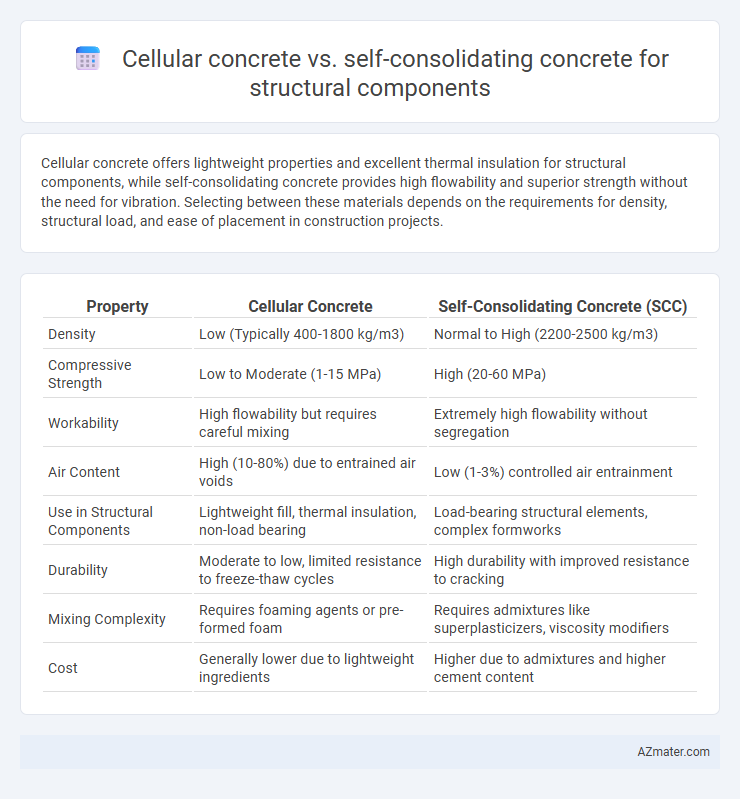Cellular concrete offers lightweight properties and excellent thermal insulation for structural components, while self-consolidating concrete provides high flowability and superior strength without the need for vibration. Selecting between these materials depends on the requirements for density, structural load, and ease of placement in construction projects.
Table of Comparison
| Property | Cellular Concrete | Self-Consolidating Concrete (SCC) |
|---|---|---|
| Density | Low (Typically 400-1800 kg/m3) | Normal to High (2200-2500 kg/m3) |
| Compressive Strength | Low to Moderate (1-15 MPa) | High (20-60 MPa) |
| Workability | High flowability but requires careful mixing | Extremely high flowability without segregation |
| Air Content | High (10-80%) due to entrained air voids | Low (1-3%) controlled air entrainment |
| Use in Structural Components | Lightweight fill, thermal insulation, non-load bearing | Load-bearing structural elements, complex formworks |
| Durability | Moderate to low, limited resistance to freeze-thaw cycles | High durability with improved resistance to cracking |
| Mixing Complexity | Requires foaming agents or pre-formed foam | Requires admixtures like superplasticizers, viscosity modifiers |
| Cost | Generally lower due to lightweight ingredients | Higher due to admixtures and higher cement content |
Introduction to Cellular Concrete and Self-Consolidating Concrete
Cellular concrete is a lightweight material composed of cement, water, and pre-formed foam, offering excellent thermal insulation and reduced density beneficial for non-load-bearing structural components. Self-consolidating concrete (SCC) possesses high flowability and stability, enabling it to fill complex formwork without mechanical vibration, making it ideal for intricate structural elements requiring superior surface finish and high strength. Both materials serve distinct purposes in structural applications, with cellular concrete prioritizing lightweight and insulation, while SCC addresses durability and ease of placement in dense reinforcement zones.
Composition and Material Properties
Cellular concrete consists of cement, water, and pre-formed foam, resulting in lightweight material with air voids that reduce density and thermal conductivity but lower compressive strength. Self-consolidating concrete (SCC) contains high-range water reducers, viscosity modifiers, and optimized aggregate gradation, providing high flowability, segregation resistance, and enhanced compressive strength suitable for complex structural components. The porous structure of cellular concrete favors insulation and lightweight applications, while SCC's dense matrix offers superior durability and load-bearing capacity for structural elements.
Structural Strength and Load-Bearing Capacity
Cellular concrete exhibits lower structural strength and reduced load-bearing capacity compared to self-consolidating concrete, largely due to its porous structure and lightweight composition. Self-consolidating concrete offers superior compressive strength and enhanced load distribution, making it ideal for critical structural components requiring high durability. The dense matrix and fine particle packing of self-consolidating concrete contribute to its exceptional performance under heavy load-bearing conditions.
Workability and Placement Techniques
Cellular concrete offers exceptional workability due to its lightweight and flowable consistency, enabling easy placement in complex geometries without segregation or bleeding. Self-consolidating concrete (SCC) exhibits superior flowability and deformability, allowing it to fill intricate formworks and densely reinforced sections purely by its own weight, minimizing the need for mechanical vibration. Placement techniques for cellular concrete typically involve pumping or pouring with minimal compaction, while SCC demands precise mix design to maintain viscosity and prevent blocking during flow in structural components.
Durability and Lifespan Considerations
Cellular concrete exhibits superior thermal insulation and lightweight properties, enhancing durability in freeze-thaw environments but generally has lower compressive strength, limiting lifespan in high-load structural components. Self-consolidating concrete (SCC) offers high density and uniformity, leading to exceptional compressive strength, reduced permeability, and enhanced resistance to chemical attacks, which significantly extends structural lifespan. For structural components requiring durability under heavy loads and aggressive exposure, SCC is typically favored due to its robust mechanical performance and long-term durability.
Thermal and Acoustic Insulation Performance
Cellular concrete exhibits superior thermal insulation due to its high porosity and air entrapped within its matrix, resulting in lower thermal conductivity compared to self-consolidating concrete (SCC). In acoustic insulation, the lightweight and porous structure of cellular concrete effectively reduces sound transmission, whereas SCC, being denser and less porous, offers limited soundproofing capabilities. For structural components requiring enhanced energy efficiency and noise reduction, cellular concrete provides significant advantages over self-consolidating concrete in both thermal and acoustic performance.
Cost Analysis and Economic Feasibility
Cellular concrete offers significant cost savings due to its lightweight nature, reducing transportation and labor expenses, while also providing excellent thermal insulation properties that enhance building energy efficiency. Self-consolidating concrete (SCC), though more expensive initially due to high-quality admixtures and specialized mix designs, minimizes labor costs and speeds up construction by eliminating the need for vibration. Economic feasibility favors cellular concrete for projects prioritizing lightweight and insulation, whereas SCC is preferred in complex structural components requiring high strength and superior surface finish despite higher material costs.
Environmental Impact and Sustainability
Cellular concrete offers superior thermal insulation and reduced material use, significantly lowering its carbon footprint compared to traditional concrete. Self-consolidating concrete minimizes waste through high flowability, reducing labor energy and ensuring precise placement without vibration, which improves durability and extends structural lifespan. Both materials contribute to sustainable construction, with cellular concrete excelling in energy efficiency and self-consolidating concrete optimizing resource use for structural components.
Recommended Structural Applications
Cellular concrete is recommended for non-load-bearing structural components such as insulation panels, lightweight partition walls, and fill material due to its low density and thermal properties. Self-consolidating concrete (SCC) is preferred for load-bearing structural components like columns, beams, and slabs where high strength, excellent flowability, and full consolidation without vibration are critical. Structural applications of SCC benefit from improved durability, surface finish, and reduced labor costs in complex formworks compared to cellular concrete.
Comparative Summary and Final Recommendations
Cellular concrete offers lightweight properties and excellent thermal insulation, making it suitable for non-load-bearing structural components with reduced density requirements. Self-consolidating concrete (SCC) provides superior flowability and high strength, ideal for complex formworks and load-bearing structural elements requiring minimal vibration during placement. For structural components demanding high strength and durability, SCC is recommended, whereas cellular concrete is preferred for applications prioritizing reduced weight and thermal performance.

Infographic: Cellular concrete vs Self-consolidating concrete for Structural component
 azmater.com
azmater.com